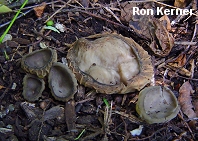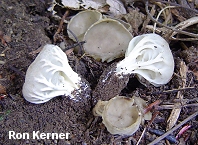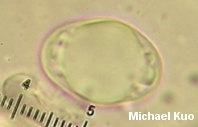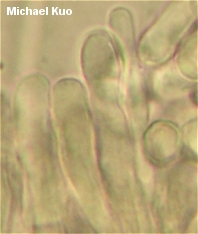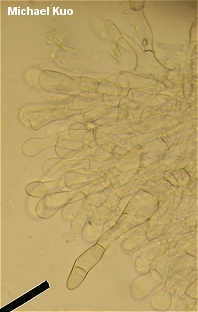| Major Groups > Cup Fungi > Helvella costifera |

|
Helvella costifera [ Ascomycetes > Pezizales > Helvellaceae > Helvella . . . ] by Michael Kuo This is a gorgeous mushroom, with its gray, cuplike cap, its ornately ribbed stem, and the often dramatic extension of the stem's ribs onto the undersurface of the cap. If you are not convinced that it is truly distinct from the better known Helvella acetabulum . . . well, I can't say I blame you. I go back and forth on this one. North American mycologists have used four characters to separate Helvella costifera from Helvella acetabulum: It has a gray, rather than yellow-brown, cap; the ribs on its stem are generally rounded and blunt-edged, rather than sharp-edged; its spores are sometimes slightly smaller; and the pigment in the cells of its excipular surface resides only in the cell walls, rather than inside the cells. Actually, that last character was used by Nancy Weber (1972) to separate what she called "Helvella griseoalba" from Helvella acetabulum and from Helvella costifera, which she believed to be strictly European. But Abbot & Currah (1997) found the distinction to be insignificant, and synonymized Weber's species. The Helvella acetabulum group, obviously, is in need of contemporary study. If I were a betting man (I'm not), I would bet on the likelihood that there are several, or even many, North American species in the group, none of which is a phylogenetic match for the European species acetabulum or costifera. This would result in Weber's name griseoalba regaining its validity, despite the fact that her hypothesis about the pigmentation of excipular cells in Helvella might be inaccurate. Thanks to Ron Kerner and Ed Lubow for documenting, collecting, and preserving Helvella costifera for study; their collections are deposited in The Herbarium of Michael Kuo. Description: Ecology: Probably mycorrhizal; growing alone or gregariously, under hardwoods or conifers, often in disturbed ground settings; spring through fall; widely distributed in northern and eastern North America. Cap: 1.5-4.5 cm across; cup-shaped, sometimes becoming more or less flat in age; the margin initially somewhat inrolled; upper surface medium to dark gray-brown or gray, bald, and smooth; undersurface grayish, or sometimes whitish near the stem, finely fuzzy, with forked whitish, blunt, round-edged ribs that extend from the stem, sometimes almost to the margin. Stem: 1-2 cm long; up to 1 cm thick; becoming broader near the cap; deeply ribbed with blunt-edged ribs that extend onto the undersurface of the cap; occasionally developing pockets; white; bald or finely hairy. Microscopic Features: Spores 14.5-20 x 9.5-12.5 µ; elliptical; smooth; with one central oil droplet. Asci 8-spored. Paraphyses cylindric with subclavate to clavate apices; 4-6 µ wide; hyaline to brownish. Excipular surface elements hyaline to brownish (but when brownish, the pigment resides in the cell walls rather than being intracellular); often arranged in bundles; frequently septate; terminal cells clavate to pyriform. REFERENCES: Nannfeldt, 1953. (Smith Weber, 1972 [H. griseoalba]; Barron, 1999; Abbot & Currah, 1997.) Herb. Kuo 05260601, 08120706. This site contains no information about the edibility or toxicity of mushrooms. |
© MushroomExpert.Com |
|
Cite this page as: Kuo, M. (2012, October). Helvella costifera. Retrieved from the MushroomExpert.Com Web site: http://www.mushroomexpert.com/helvella_costifera.html |
